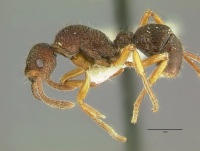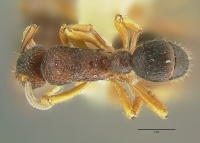Stictoponera macretes
| Stictoponera macretes | |
|---|---|

| |
| Scientific classification | |
| Kingdom: | Animalia |
| Phylum: | Arthropoda |
| Class: | Insecta |
| Order: | Hymenoptera |
| Family: | Formicidae |
| Subfamily: | Ectatomminae |
| Tribe: | Ectatommini |
| Genus: | Stictoponera |
| Species: | S. macretes |
| Binomial name | |
| Stictoponera macretes (Brown, 1958) | |
Specimens of S. macretes have been found in rotten logs in rainforest.
Identification
Lattke (2004) - This species seems to be a sister species of Stictoponera niuguinensis based on several synapomorphies such as lack of an occipital lobe and shared trends of surface sculpture. S. macretes differs from S. niuguinensis in the following characters: clypeal lamella protruding less, scape mostly smooth, occipital lamella convex, tibiae longitudinally strigulose punctate, femora and tibiae smooth, meso- and metafemora with convex apical paired lobes, fore tarsus opposite strigil with a single stout seta.
Distribution
Latitudinal Distribution Pattern
Latitudinal Range: 9.421° to -9.300000191°.
| North Temperate |
North Subtropical |
Tropical | South Subtropical |
South Temperate |
- Source: AntMaps
Distribution based on Regional Taxon Lists
Indo-Australian Region: New Guinea (type locality).
Distribution based on AntMaps
Distribution based on AntWeb specimens
Check data from AntWeb
Countries Occupied
| Number of countries occupied by this species based on AntWiki Regional Taxon Lists. In general, fewer countries occupied indicates a narrower range, while more countries indicates a more widespread species. |

|
Estimated Abundance
| Relative abundance based on number of AntMaps records per species (this species within the purple bar). Fewer records (to the left) indicates a less abundant/encountered species while more records (to the right) indicates more abundant/encountered species. |

|
Biology
Castes
Nomenclature
The following information is derived from Barry Bolton's Online Catalogue of the Ants of the World.
- macretes. Gnamptogenys macretes Brown, 1958g: 313 (w.q.m.) NEW GUINEA (Papua New Guinea).
- Type-material: holotype worker, 6 paratype workers, 3 paratype queens, 3 paratype males.
- Type-locality: holotype Papua New Guinea: Bisianumu, nr Sogeri, no. 649 (E.O. Wilson); paratypes: 6 workers, 2 queens, 3 males with same data, 1 queen with same data but no.655.
- Type-depository: MCZC.
- Combination in Stictoponera: Camacho, Franco, Branstetter, et al. 2022: 12.
- Status as species: Bolton, 1995b: 209; Lattke, 2004: 122 (redescription); Camacho, Franco, Branstetter, et al. 2022: 12.
- Distribution: Papua New Guinea.
Unless otherwise noted the text for the remainder of this section is reported from the publication that includes the original description.
Lattke (2004) - Occipital lobe lacking, occipital lamella prominent and convex. Postpetiolar dorsum striate with scattered piligerous punctae, striae transverse on anterior face curving around medially becoming longitudinal posterad. Dorsum of abdominal segment 4 with narrow anteromedian strip of transverse striae posteriorly bordered by arching low sulcus, with a patch of longitudinal striae extending on anterior one-third to one-half, striae longest medially becoming progressively shorter laterally, rest of tergite mostly smooth with scattered punctures.
Description
Worker
Lattke (2004) - Metrics (n = 4): HL 1.20-1.28, HW 1.01-1.10, ML 0.61-0.67, SL 1.09-1.18, ED 0.27-0.31, WL 1.72-1.84 mm. CI 0.82-0.88, SI 1.07-1.10, MI 0.57-0.61, OI 0.27-0.29. Head subquadrate with longitudinal lateral margins in frontal view, posterior margin relatively straight, anterior margin of clypeal lamella ending in median blunt angle; frons with strigae forming posteriorly diverging rows surrounding round to oval smooth-bottomed foveolae, with strigulae between foveolae; clypeus longitudinally strigulose, strigulae partially extending onto lamella. Scape mostly smooth with scattered piligerous punctae; mandibular dorsum mostly longitudinally costulae; occipital lobe lacking, occipital lamella prominent and convex. Lateral pronotal face mostly foveolate, strigulae present posterad, posteromedian corner mostly smooth with some punctae; anepisternum mostly smooth with some foveolaepunctae; katepisternum with abundant round to oval foveolae and scattered low strigulae; metapleuron anterodorsally undulate to vaguely strigulose, posteroventrally longitudinally strigulose; promesonotum densely foveolate in dorsal view, foveolae forming approximate concentric circles around median patch of longitudinal strigulae; promesonotal suture vaguely impressed; propodeum densely foveolate to areolate, declivity mostly smooth.
Petiolar node with shorter posterior margin than anterior margin in lateral view, dorsum with low transverse strigulae and scattered foveolae; ventral process forming anteriorly projecting narrow lobe; postpetiolar dorsum striate with scattered piligerous punctae, striae on anterior face transverse, curving around medially and becoming longitudinal posterad; postpetiole laterally with anterior one-third transversely strigulose, dorsal half longitudinally strigulose, posteroventral corner mostly smooth; postpetiolar sternum mostly smooth with very low transverse rugulae and undulations; dorsum of abdominal segment 4 with narrow anteromedian strip of transverse striae posteriorly bordered by arching low sulcus; longitudinal striae extend along anterior one-half to one-third of tergite, striae longest medially, becoming progressively shorter laterally, rest of tergite mostly smooth with scattered punctae. Fore coxa mostly smooth with variable degree of transverse strigulae apically in lateral view; fore tarsus opposite strigil with one stout seta. Dorsum of thorax and abdominal segments 1-4 with scattered erect to subdecumbent hairs. Head, mesosoma, petiole, and gaster brown; mandibles, antennae, legs ferruginous.
Queen
Lattke (2004) - Metrics (n = 2): HL 1.28,1.29; HW 1.10, 1.09; ML 0.66, 0.68; SL 1.20, 1.22; ED 0.34, 0.35; WL 2.06, 1.98 mm. CI 0.85, 0.85; SI 1.09, 1.12; MI 0.60, 0.62; OI 0.31, 0.32. Pronotum mostly foveolate with dorsomedian smooth area, ventral margin pitted with irregular punctae and strigulae in lateral view; mesonotum longitudinally strigulose-punctate; anepisternum longitudinally strigulose, with scattered foveolae; katepisternum with variable degree of longitudinal strigulae, foveolae and punctae present especially posteriorly.
Male
Lattke (2004) - Metrics (n = 1): HL 0.89, HW 0.74, ML 0.49, SL 0.30, ED 0.34, WL 1.69 mm. CI 0.83, SI 0.41, MI 0.66, OI 0.46. Clypeus with fine longitudinal strigulae, with longitudinal carina extending posterad from clypeus to posterior antennal socket level, reappearing just before median ocellus; gena rugulose; scape mostly smooth with abundant piligerous punctulae, especially basally; frons with irregular rugulae and broad smooth to undulate space in between; mesoscutum mostly smooth with scattered foveolae, axillae longitudinally carinate, scutellum mostly smooth with scattered foveolae; propodeum rugulose with undulate cuticle in between; dorsum of node and gaster mostly smooth.
Type Material
Lattke (2004) - Holotype worker: New Guinea, Bisianumu, near Sogeri (Wilson) (Museum of Comparative Zoology) [Examined].
References
- Brown, W. L., Jr. 1958g. Contributions toward a reclassification of the Formicidae. II. Tribe Ectatommini (Hymenoptera). Bulletin of the Museum of Comparative Zoology 118: 173-362. (page 313, worker, queen, male described)
- Camacho, G.P., Franco, W., Branstetter, M.G., Pie, M.R., Longino, J.T., Schultz, T.R., Feitosa, R.M. 2022. UCE phylogenomics resolves major relationships among Ectaheteromorph ants (Hymenoptera: Formicidae: Ectatomminae, Heteroponerinae): A new classification for the subfamilies and the description of a new genus. Insect Systematics and Diversity 6(1): 5; 1–20 (doi:10.1093/isd/ixab026).
- Lattke, J. E. 2004. A Taxonomic Revision and Phylogenetic Analysis of the Ant Genus Gnamptogenys Roger in Southeast Asia and Australasia (Hymenoptera: Formicidae: Ponerinae). University of California Publications in Entomology 122: 1-266 (page 122, fig. 27 worker, queen, male described)
References based on Global Ant Biodiversity Informatics
- Brown W. L., Jr. 1958. Contributions toward a reclassification of the Formicidae. II. Tribe Ectatommini (Hymenoptera). Bulletin of the Museum of Comparative Zoology 118: 173-362.
- CSIRO Collection
- Janda M., G. D. Alpert, M. L. Borowiec, E. P. Economo, P. Klimes, E. Sarnat, and S. O. Shattuck. 2011. Cheklist of ants described and recorded from New Guinea and associated islands. Available on http://www.newguineants.org/. Accessed on 24th Feb. 2011.
- Lattke J. E. 2004. A taxonomic revision and phylogenetic analysis of the ant genus Gnamptogenys Roger in Southeast Asia and Australasia (Hymenoptera: Formicidae: Ponerinae). University of California Publications in Entomology 122: 1-266.
- Scott-Santos, C.P., F.A. Esteves, C.R.F. Brandao. 2008. Catalogue of "Poneromorph" ant type specimens (Hymenoptera, Formicidae) deposited in the Museu de Zoologia da Universidade de Sao Paulo, Brazil. Papeis Avulsos de Zoologia 48(11):75-88.
- Wilson Edward O. 1959. Adaptive Shift and Dispersal in a Tropical Ant Fauna. Evolution 13(1): 122-144


